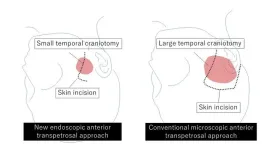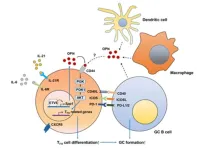(Press-News.org) Like most primates, humans are remarkably touchy-feely. Starved of touch, we release more of the stress hormone cortisol, which causes the immune system to be down-regulated and the heart rate and blood pressure to go up. On the other hand, touch causes the brain to be flooded by natural opioids, the ‘bonding hormone’ oxytocin, and the ‘feel-good’ neurotransmitters dopamine and serotonin.
It is generally assumed that our sense of touch worsens with age, just like our vision and sense of hearing. However, new results are good news for those who wished they could stave off age-related decline forever: they show for the first time that a deterioration in touch sensitivity only happens in regions of the body with hairless skin, but not in more hairy regions. The results are published in Frontiers in Aging Neuroscience.
“Touch gets worse on the hands with age, but not on our hairy arms and cheeks, of which the cheek is especially sensitive to touch,” said Dr Jean-Marc Aimonetti, a researcher at the Research Center in Psychology and Neurosciences, in Marseille, France, and one of the corresponding authors.
Testing sensitivity
The authors recruited 96 left-handed female volunteers between 20 and 75 years old and tested the sensitivity of their skin in three regions: the hairless tip of the right index finger, and the right forearm and cheek, which are typically both covered in a downy layer of hair. The women sat down in a quiet room, closing their eyes and wearing noise-canceling headphones to avoid distractions.
In the first experiment, the subjects had to blindly move the tip of their right index finger over a series of 11 plates with differently spaced grooves, between 3.6mm and 6mm wide. They had to indicate whether the grooves felt wider or narrower than those on a reference plate, 4.8mm wide. Each subject was tested 132 times, and received a score for correct responses. The results confirmed that the index finger’s sensitivity for spatial exploration through touch decreases with age.
In a similar, second experiment, the researchers applied 13 classes of monofilaments (each with a unique calibrated force between 0.08 and 75 millinewton) to the women’s skin in a randomized, dose de-escalating pattern. The subjects had to indicate whenever they sensed a touch. This experiment ended when a subject made two successive errors, indicating that she could no longer accurately detect the stimulus. This is a widely used, proven method for measuring touch sensitivity, for example in people with neuropathy from diabetes.
The results again confirmed that the detection threshold increased linearly with age for the index finger, thus showing a deterioration of touch sensitivity over the lifespan.
Keeping in touch
However, unexpectedly, no such deterioration was found for the cheek and forearm. For example, the ten youngest women had a mean detection threshold of 5.6 millinewton on the forearm, compared to a mean of 5.6 millinewton for the ten oldest women – a difference that was not statistically significant. Likewise, the mean threshold on the cheek was 0.9 millinewton for the 10 youngest women, not significantly lower than the mean of 1.1 millinewton for the ten oldest.
These results imply that the cheek remains especially responsive throughout the lifespan. This was a surprise, as hairless skin generally has a higher density of mechanoreceptors– that determine our sensitivity to touch – than hairy skin.
“Although our hands are very important for touch, we receive caresses from others more on our hairy skin. This so-called affective touch actually increases with age and preserving this sensitivity would make sense, as we are social animals,” said Aimonetti’s colleague Dr Rochelle Ackerley, the second corresponding author.
Hair is our friend
The researchers speculate that the preservation of touch sensitivity in the forearm and cheek is directly due to the presence of hairs. Hair doesn’t only protect the skin, but also acts as an antenna to transmit mechanical stimuli, including at very low forces.
“Hair is our friend. It protects us from bacteria and tell us which way the wind is blowing. It's not for nothing that we have hair in the most sensitive areas” explained Aimonetti.
But what can we do ourselves to keep our skin sensitive?
“Studies show that people exposed throughout their lives to thermal environmental extremes, such as the cold for soldiers or the heat for bakers, lose more tactile sensitivity. We can also avoid negative lifestyle factors such as alcohol, tobacco, and sun bathing, which damage the skin, as well as other factors, such as pollution,” said Ackerley.
END
Study shows hairy skin does not become less sensitive with age
Our cheeks remain exceptionally sensitive to touch throughout our lifespan
2024-07-02
ELSE PRESS RELEASES FROM THIS DATE:
Safer, swifter, smaller scar: new brain surgery approach targets difficult tumors at skull base
2024-07-02
Tumors arising in the base of the skull are among the most difficult to remove in neurosurgery. The current treatment method is to perform surgical removal by what is known as the microscopic anterior transpetrosal approach (ATPA). Seeking to lessen the risk of damage and postoperative complications, as the skull base is densely packed with nerves, blood vessels, and other tissues, not to mention the brain stem, an Osaka Metropolitan University medical research team is taking a new approach.
Led by Dr. Hiroki Morisako, a lecturer in ...
Barriers to care: transgender and gender-diverse peoples’ health care experiences
2024-07-02
Transgender, nonbinary, and gender-diverse people face barriers to accessing surgery and to the health system in general, describe authors in two new research papers published in CMAJ (Canadian Medical Association Journal).
In many areas of life, people who identify as transgender, nonbinary, and gender diverse experience discrimination even where there are laws to protect transgender human rights. Health systems also pose barriers for transgender, nonbinary, and gender-diverse people, who are more likely to delay obtaining ...
Study explores what motivates people to watch footage of disasters and extreme weather
2024-07-02
Extreme weather events such as hurricanes and storms have increased in both frequency and severity in recent years.
With that has come heightened public interest, resulting in often dramatic footage being live-streamed on platforms such as YouTube, TikTok and Discord.
Now, a new study conducted at the University of Plymouth has for the first time analysed what might be motivating people to watch these streams – in some instances for up to 12 hours at a time.
The research centred around the live-streaming ...
Ocean acidification turns fish off coral reefs
2024-07-02
A new study of coral reefs in Papua New Guinea shows ocean acidification simplifies coral structure, making crucial habitat less appealing to certain fish species.
While much media attention has focused on heat stress-induced coral bleaching, this finding, by a University of Adelaide research team led by Professor Ivan Nagelkerken, adds nuance to concerns about how global warming affects coral reefs.
Ocean acidification is caused by an increase in the level of carbon dioxide in oceanwater, leading to a reduction in pH. This makes calcium carbonate less available in the ocean, which corals use to build and repair their skeleton.
Professor Nagelkerken and ...
Will the Paris 2024 Olympics be a platform for activist protests amid global tensions?
2024-07-02
Athletes and sporting teams have frequently used the Olympics and other sporting events to make political statements through boycotts and protests. Ahead of the Paris Olympics kicking off this month and amidst the current UEFA (Union of European Football Associations) European Football Championship (Euro 2024), researchers are asking – should sport be a platform for promoting social justice issues?
The 2024 Paris Olympics, like the Euro 2024 soccer tournament, will be watched by billions of people and command media attention around the globe. ...
Mechanism of lupus pathogenesis unveiled
2024-07-02
A research team of Professor Yoontae Lee and Jiho Park, a PhD candidate, from the Department of Life Sciences at Pohang University of Science and Technology (POSTECH) recently discovered that a particular protein promotes the development of systemic lupus erythematosus (SLE). The study was published in the Proceedings of the National Academy of Sciences of the United States of America (PNAS), one of the world's most-cited multidisciplinary scientific journal.
B cells, components of the body's ...
How well do deep-sea animals perform under pressure?
2024-07-02
A multi-institutional team that includes researchers from the University of Delaware, University of California San Diego and Monterey Bay Aquarium Research Institute (MBARI), among others, published a paper in Science on Thursday, June 27, that provides new insight on how deep-sea “comb jellies” called ctenophores adapt and survive at extreme pressures.
It turns out that part of the adaptation involves lipids, fatty chemical compounds found in the membrane of all living cells that perform essential functions, including storing energy, sending signals and controlling what passes through ...
FDA staff leaving for industry jobs given “behind the scenes” lobbying advice
2024-07-02
The US Food and Drug Administration (FDA) tells staff leaving for industry jobs that, despite restrictions on post-employment lobbying, they are still permitted to influence the agency, reveals an investigation by The BMJ today.
Internal emails, obtained under a freedom of information request, show how two FDA officials who worked on covid-19 vaccine approvals were proactively informed by FDA ethics staff about their ability to indirectly lobby the agency as they left for jobs with Moderna.
The record shows that since 2000 every FDA commissioner, the agency’s highest position, has gone on to work ...
Herpes infections take major economic toll globally, new research shows
2024-07-02
Genital herpes infections and their related complications lead to billions of dollars in health care expenditures and productivity losses globally, according to the first ever global estimates of the economic costs of these conditions.
The paper, which publishes July 1st in the journal BMC Global and Public Health, calls for greater investment in prevention of herpes transmission, including concerted efforts to develop effective vaccines against this common virus.
Corresponding author Nathorn Chaiyakunapruk, PharmD, PhD, professor of pharmacotherapy, and Haeseon Lee, PharmD, research fellow in pharmacotherapy, both at the College of Pharmacy of University ...
Tax on antibiotics could help tackle threat of drug-resistance
2024-07-02
Taxing certain antibiotics could help efforts to tackle the escalating threat of antibiotic resistance in humans, according to a new study by the University of East Anglia’s Centre for Competition Policy, Loughborough University and E.CA Economics.
Antimicrobial resistance (AMR) poses a significant global risk, causing an estimated 700,000 deaths annually. A key AMR report previously warned that if unchecked, it could endanger 10 million lives a year and result in $100 trillion in lost economic output ...
LAST 30 PRESS RELEASES:
Jeonbuk National University study shows positive parenting can protect adolescents against self-harm
Surface-engineered ZnO nanocrystals to tackle perfluoroalkyl substance contamination
This new understanding of T cell receptors may improve cancer immunotherapies
A new fossil face sheds light on early migrations of ancient human ancestor
A new immunotherapy approach could work for many types of cancer
A new way to diagnose deadly lung infections and save lives
40 percent of MRI signals do not correspond to actual brain activity
How brain-inspired algorithms could drive down AI energy costs
Gum disease may be linked to plaque buildup in arteries, higher risk of major CVD events
Contrails are a major driver of aviation’s climate impact
Structure of dopamine-releasing neurons relates to the type of circuits they form for smell-processing
Reducing social isolation protects the brain in later life
Keeping the heart healthy increases longevity even after cancer
Young adults commonly mix cannabis with nicotine and tobacco
Comprehensive review illuminates tau protein's dual nature in brain health, disease, and emerging psychiatric connections
Book prepares K-12 leaders for the next public health crisis
Storms in the Southern Ocean mitigates global warming
Seals on the move: Research reveals key data for offshore development and international ecology
Sports injuries sustained during your period might be more severe
World's first successful 2 Tbit/s free-space optical communication using small optical terminals mountable on satellites and HAPS
Can intimate relationships affect your heart? New study says ‘yes’
Scalable and healable gradient textiles for multi‑scenario radiative cooling via bicomponent blow spinning
Research shows informed traders never let a good climate crisis go to waste
Intelligent XGBoost framework enhances asphalt pavement skid resistance assessment
Dual-function biomaterials for postoperative osteosarcoma: Tumor suppression and bone regeneration
New framework reveals where transport emissions concentrate in Singapore
NTP-enhanced lattice oxygen activation in Ce-Co catalysts for low-temperature soot combustion
Synergistic interface engineering in Cu-Zn-Ce catalysts for efficient CO2 hydrogenation to methanol
COVID-19 leaves a lasting mark on the human brain
Scientists use ultrasound to soften and treat cancer tumors without damaging healthy tissue
[Press-News.org] Study shows hairy skin does not become less sensitive with ageOur cheeks remain exceptionally sensitive to touch throughout our lifespan





